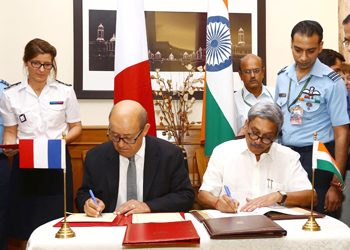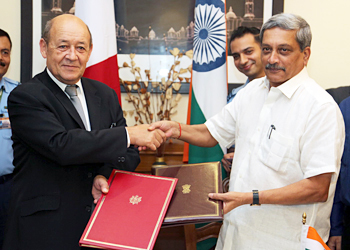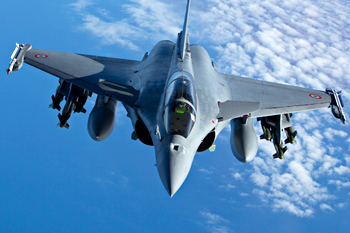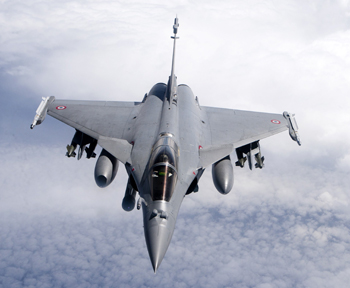INDIAN ARMED FORCES CHIEFS ON
OUR RELENTLESS AND FOCUSED PUBLISHING EFFORTS

SP Guide Publications puts forth a well compiled articulation of issues, pursuits and accomplishments of the Indian Army, over the years

I am confident that SP Guide Publications would continue to inform, inspire and influence.

My compliments to SP Guide Publications for informative and credible reportage on contemporary aerospace issues over the past six decades.
- Prime Minister witnesses 'Bharat Shakti' – a Tri-Services Firing and Manoeuvre Exercise in Pokhran, Rajasthan
- Interim Defence Budget 2024-25 — An Analysis
- Union Defence budget 2024
- Prime Minister Modi Commemorates Indian Navy Day in a Grand Ceremony
- Prime Minister Modi Flies in the LCA Tejas
- New Chapter in India-Italy Defence Ties
- Airpower beyond Boundaries
The Rafale Deal – Finally Inked

By Lt. General P.C. Katoch (Retd)
Former Director General of Information Systems, Indian Army
 The Union Minister for Defence, Manohar Parrikar and the French Defence Minister, Jean-Yves Le Drian, signing the intergovernmental agreement on Rafale, in New Delhi on September 23, 2016
The Union Minister for Defence, Manohar Parrikar and the French Defence Minister, Jean-Yves Le Drian, signing the intergovernmental agreement on Rafale, in New Delhi on September 23, 2016
 The Union Minister for Defence, Manohar Parrikar and the French Defence Minister, Jean-Yves Le Drian, exchanging the Rafale contract agreement, in New Delhi on September 23, 2016
The Union Minister for Defence, Manohar Parrikar and the French Defence Minister, Jean-Yves Le Drian, exchanging the Rafale contract agreement, in New Delhi on September 23, 2016


16 years after the IAF projected the demanded for new multi-role fighters and four years after the Rafale deal was mooted in 2012, India has finally signed the agreement with France for 36 Rafale fighters. Defence Minister Manohar Parrikar and French Defence Minister Jean-Yves Le Drian signed the deal at a ceremony in New Delhi on September 23. Inked at Euro 7.87 billion, it is one of the biggest import deal signed by India in recent decades. All the 36 fighters are to be imported from France. While the first Rafale is to be received by India within three years, all 36 will be received by early 2022. The Rafale is armed with the Meteor air-to-air missiles that have a range of 150 kms, which will give a combat edge over the F-16 fighter aircraft held by Pakistan sine the missiles onboard F-16 have a range of 80 kms. According to French aircraft manufacturer Dassault Aviation's CEO Eric Trappier the Rafale is more in competition with the American F-35 fifth-generation fighter because it is a generation ahead of the F-16.
These 36 Rafale fighters will be tweaked to specific multiple Indian requirements. These will include requirements like capability for cold start at high-altitude regions like Leh, Israeli helmet-mounted displays, advanced missile warning and synthetic aperture radars etc. The deal does not put any restrictions for the Rafale to carry nuclear weapons and for using them as strategic platforms. The overall per unit cost of the 36 Rafales being imported will be some Rs 1,640 crore taking into account the weapon package, complete spares and costs for 75 per cent fleet availability, plus performance-based logistics support for five years. Though different fighters cannot be compared since they have their own roles and capabilities, India can buy two to three Russian heavy-weight Sukhoi-30MKIs or five to six indigenous Tejas light combat aircraft for every Rafale.
But it's also true that while a Tejas has a limited range of 400 km and weapon load-carrying capability of 2.5 tonnes, a Rafale can go up to 1,650 km with a 9.3-tonne load. India will pay around 15 per cent (around Rs 9,000 crore) as the first installment. Under this logistics support, Dassault will ensure that at least 75 per cent of the fleet remains operational or air worthy at any given time under what is called the existing frontline fighter, the Sukhoi 30-MKI has only 60 per cent availability clause. The Rafale deal has a 50 per cent offsets clause, under which France will have to invest half of the actual contract value (some 3.94 euros) back into India, which has the potential to generate direct and indirect employment opportunities in India. According to government sources, India saved some Euros 328 million from bargaining over the price for the original medium multi role combat aircraft (MMRCA) being negotiated by the erstwhile UPA regime. The Rafale deal does fall short of previous proposals for India to buy 126 of the jets because of costs and assembly guarantees. Rafale aircraft are currently being used for bombing missions over Syria and Iraq. The Rafale can fly distances of up to 3,800 kms (2,360 miles).
Significantly, the Rafales will come with much better weapons and maintenance support packages now as compared to what was being negotiated by the previous government. The Rafale has a faster turnaround time, capable of undertaking five sorties in a day. The French company will make India-specific changes, such as next generation missiles like Meteor and Scalp, which will add capability much beyond India’s immediate adversaries. The Meteor, is a BVR (Beyond Visual Range) air-to-air missile with a range in excess of 150 km. It will allow IAF to hit targets inside both Pakistan and Tibet from within its own territory. The Scalp is a long-range air-to- cruise missile with a range of 300 km and precision of two metres. The IAF has not procured any new fighter jets since the start of this century, the last one being the Sukhoi 30-MKI from Russia that was first ordered in mid-1990’s and since have been produced under license in India by HAL. The Rafale will certainly be a boost for the IAF, however the real edge will come when we build our own fifth generation fighter aircraft (FGFA) in India. Our plans for joint development of FGFA in collaboration with Russia need to be accelerated in this context.
Photo Credit: PIB, Dassault Aviation, French Air Force – R. Nicolas-Nelson
 |
By Lt. General P.C. Katoch (Retd) Former Director General of Information Systems, Indian Army |




16 years after the IAF projected the demanded for new multi-role fighters and four years after the Rafale deal was mooted in 2012, India has finally signed the agreement with France for 36 Rafale fighters. Defence Minister Manohar Parrikar and French Defence Minister Jean-Yves Le Drian signed the deal at a ceremony in New Delhi on September 23. Inked at Euro 7.87 billion, it is one of the biggest import deal signed by India in recent decades. All the 36 fighters are to be imported from France. While the first Rafale is to be received by India within three years, all 36 will be received by early 2022. The Rafale is armed with the Meteor air-to-air missiles that have a range of 150 kms, which will give a combat edge over the F-16 fighter aircraft held by Pakistan sine the missiles onboard F-16 have a range of 80 kms. According to French aircraft manufacturer Dassault Aviation's CEO Eric Trappier the Rafale is more in competition with the American F-35 fifth-generation fighter because it is a generation ahead of the F-16.
These 36 Rafale fighters will be tweaked to specific multiple Indian requirements. These will include requirements like capability for cold start at high-altitude regions like Leh, Israeli helmet-mounted displays, advanced missile warning and synthetic aperture radars etc. The deal does not put any restrictions for the Rafale to carry nuclear weapons and for using them as strategic platforms. The overall per unit cost of the 36 Rafales being imported will be some Rs 1,640 crore taking into account the weapon package, complete spares and costs for 75 per cent fleet availability, plus performance-based logistics support for five years. Though different fighters cannot be compared since they have their own roles and capabilities, India can buy two to three Russian heavy-weight Sukhoi-30MKIs or five to six indigenous Tejas light combat aircraft for every Rafale.
But it's also true that while a Tejas has a limited range of 400 km and weapon load-carrying capability of 2.5 tonnes, a Rafale can go up to 1,650 km with a 9.3-tonne load. India will pay around 15 per cent (around Rs 9,000 crore) as the first installment. Under this logistics support, Dassault will ensure that at least 75 per cent of the fleet remains operational or air worthy at any given time under what is called the existing frontline fighter, the Sukhoi 30-MKI has only 60 per cent availability clause. The Rafale deal has a 50 per cent offsets clause, under which France will have to invest half of the actual contract value (some 3.94 euros) back into India, which has the potential to generate direct and indirect employment opportunities in India. According to government sources, India saved some Euros 328 million from bargaining over the price for the original medium multi role combat aircraft (MMRCA) being negotiated by the erstwhile UPA regime. The Rafale deal does fall short of previous proposals for India to buy 126 of the jets because of costs and assembly guarantees. Rafale aircraft are currently being used for bombing missions over Syria and Iraq. The Rafale can fly distances of up to 3,800 kms (2,360 miles).
Significantly, the Rafales will come with much better weapons and maintenance support packages now as compared to what was being negotiated by the previous government. The Rafale has a faster turnaround time, capable of undertaking five sorties in a day. The French company will make India-specific changes, such as next generation missiles like Meteor and Scalp, which will add capability much beyond India’s immediate adversaries. The Meteor, is a BVR (Beyond Visual Range) air-to-air missile with a range in excess of 150 km. It will allow IAF to hit targets inside both Pakistan and Tibet from within its own territory. The Scalp is a long-range air-to- cruise missile with a range of 300 km and precision of two metres. The IAF has not procured any new fighter jets since the start of this century, the last one being the Sukhoi 30-MKI from Russia that was first ordered in mid-1990’s and since have been produced under license in India by HAL. The Rafale will certainly be a boost for the IAF, however the real edge will come when we build our own fifth generation fighter aircraft (FGFA) in India. Our plans for joint development of FGFA in collaboration with Russia need to be accelerated in this context.
Photo Credit: PIB, Dassault Aviation, French Air Force – R. Nicolas-Nelson





